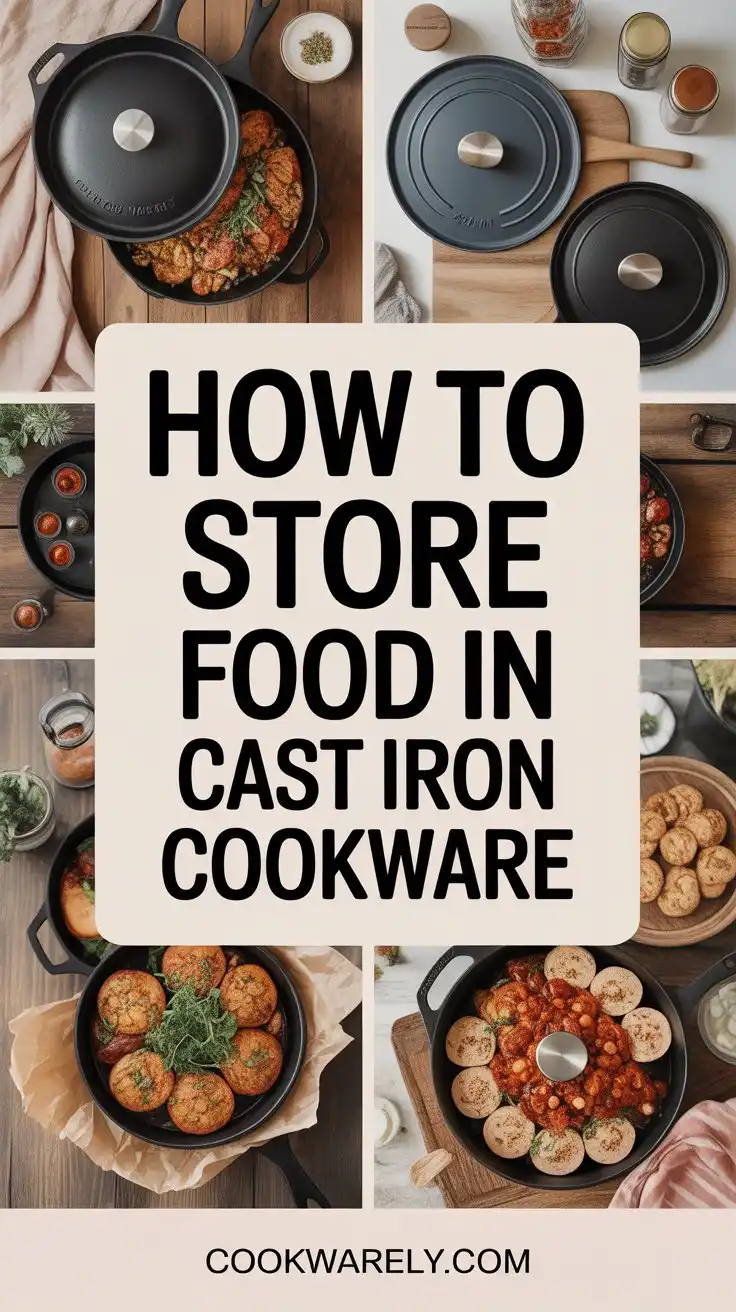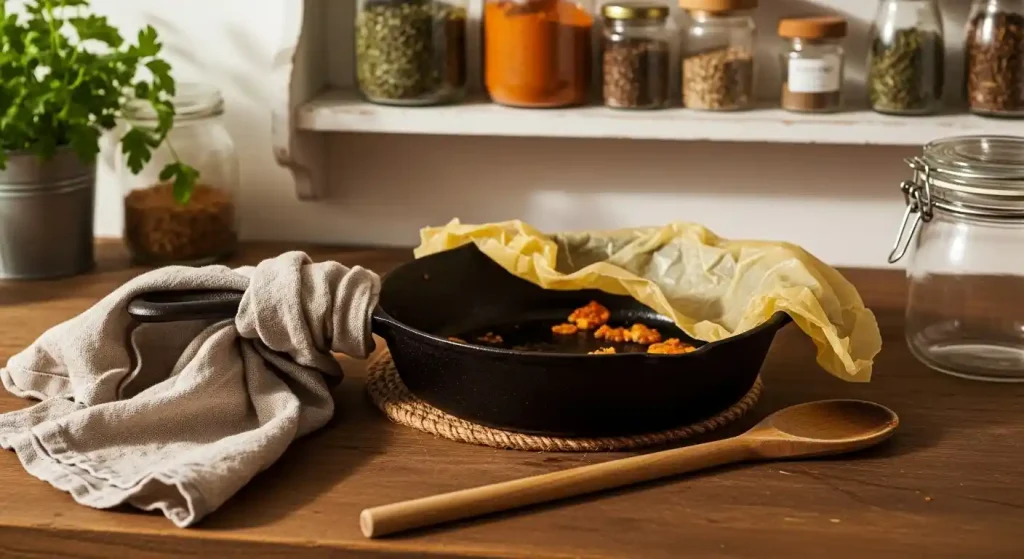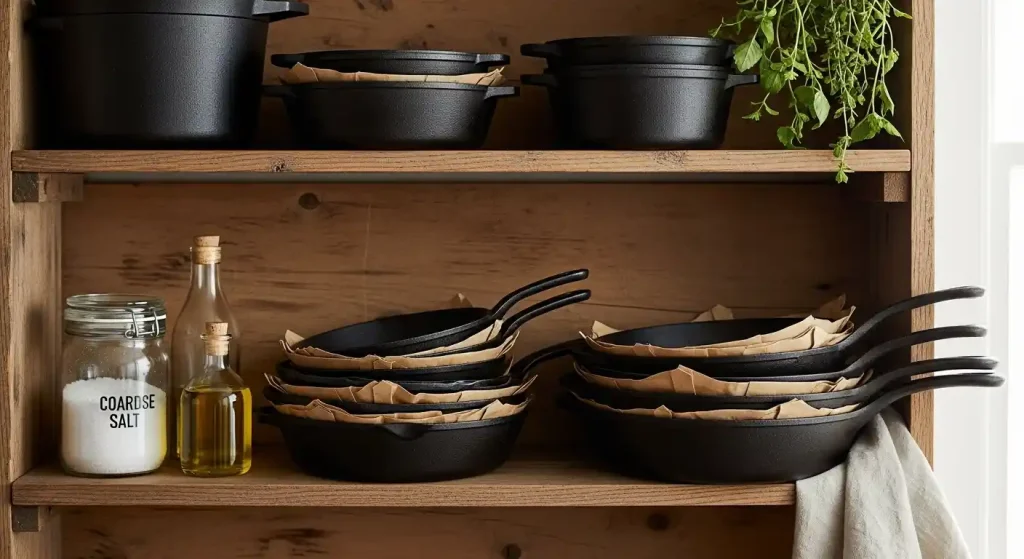How To Store Food In Cast Iron Cookware?
Have you ever finished cooking in your cast iron skillet and wondered… can I just leave the food in here?
I’ve been there too.
When I first started using cast iron, I had no idea what I was doing—seasoning, cleaning, storing—it all felt like some secret club I didn’t have the password for.
But over time, I figured it out (after a few rusty mishaps and soggy leftovers), and now I actually love using cast iron—not just for cooking, but even for storing food… the right way.
🎄 Christmas & Year-End Amazon Deals !
Don’t miss out on the best discounts and top-rated products available right now!
*As an Amazon Associate, I earn from qualifying purchases.
So if you’re not sure whether it’s safe to store food in cast iron, how long it’ll last, or how to avoid ruining your pan, don’t worry—I’ve got you covered.
Let’s break down everything you need to know to store food safely and keep your cast iron in top shape.

Why It Matters: The Case for Proper Food Storage in Cast Iron
Before diving into methods and tips, it’s important to understand why storing food in cast iron needs care.
Cast iron is durable, yes, but it’s also reactive. Leaving food—especially acidic items—can affect both the seasoning and the flavor.
The way you store food can determine whether your pan stays non-stick and rust-free or becomes a frustrating, sticky mess.
Think of this as a guide not just for storing food but also for preserving your investment.
Key Considerations Before You Store Anything

- Is your pan properly seasoned? A well-seasoned pan resists sticking and rusting—essential if you’re storing food in it.
- What kind of food are you storing? Acidic ingredients like tomatoes, vinegar, and citrus can eat away at your seasoning.
- How long will the food sit? Storing overnight might be okay, but anything longer needs more precautions.
The Right Approach: How To Store Food in Cast Iron Cookware
Cast iron is incredibly durable, but it still needs a little extra love when it comes to food storage.
If you’re planning to leave food in your skillet or Dutch oven for any period of time, these steps can help preserve both the flavor of your meal and the condition of your cookware.

1. Guidelines and Instructions for Safe Storage
Before even thinking about putting your cast iron in the fridge or letting it sit on the counter overnight, remember that cast iron isn’t like stainless steel or glass—it’s porous and reactive.
Food left sitting in the pan can cause the seasoning to break down, especially if it’s moist or acidic.
As a rule of thumb:
- Store food only for short durations (under 24 hours).
- Avoid storing tomato-based dishes, citrusy sauces, or vinegar-heavy meals.
- If you notice metallic or off flavors after storing food, it’s a sign your pan’s seasoning is compromised.
2. What To Do Right After Cooking
Once your meal is finished and you’ve got leftovers, here’s what you should do:
- Let the food cool slightly, but don’t let it sit in the hot pan for too long.
- Use a silicone spatula or wooden spoon to gently remove all the food from the pan.
- If you plan to store it in the same pan (for very short term), clean the edges and wipe down any excess sauce or moisture from the surface.
Pro tip: Never store burnt or stuck-on bits in the pan. They’ll soak up moisture and damage the seasoning.
3. How To Cool and Store Properly
If you do want to store food in the pan itself (such as a stew, soup, or baked dish), follow these steps:
🎄 Christmas & Year-End Amazon Deals !
Don’t miss out on the best discounts and top-rated products available right now!
*As an Amazon Associate, I earn from qualifying purchases.
- Allow the pan and food to cool to room temperature before storing. Putting hot cast iron in the fridge can cause thermal shock, potentially warping the pan or damaging your fridge shelf.
- Once cooled, place the pan in the fridge. Try to store it on a flat surface to avoid tipping or uneven cooling.
If you’re worried about long-term exposure, transfer the food to a glass or plastic storage container instead and clean and oil your cast iron promptly.
4. Tips for Covering or Sealing Food
Cast iron pans rarely come with airtight lids. If you plan to store food in them:
- Use a tight-fitting metal lid if available (especially for Dutch ovens).
- If not, tightly cover the pan with aluminum foil or plastic wrap.
- Avoid rubber or plastic lids unless the food has fully cooled.
- You can also place a sheet of parchment paper or wax paper between the food and the lid to reduce moisture contact and prevent flavor absorption.
5. Whether or Not to Refrigerate
You can refrigerate food in cast iron, but it’s best to do so only under the right conditions:
-
Yes, if:
- The food is mild (not acidic).
- The storage is short (overnight or up to 24 hours).
- The pan is well-seasoned and in good condition.
-
No, if:
- The food contains tomato sauce, lemon, vinegar, or wine.
- You’re storing for multiple days.
- Your pan is new or has visible rust or flaky seasoning.
Also note that refrigerating cast iron can draw out moisture from the food, which may cause rust if the pan isn’t completely sealed or the seasoning isn’t solid.
6. Avoiding acidic foods
A good cast iron pan is a great kitchen tool, but it can be a pain to cook acidic foods in it.
Many warn against this practice, saying that acidic food will leave a metallic taste on the pan and ruin its seasoning.
A layer of solidified oil that gives a cast iron pan its non-stick surface.
Foods high in acid are most commonly fish and tomatoes.
The seasoning of your cast-iron pan helps protect it from acidic foods by creating a barrier between the acidic food and the pan.
However, this buffer only works up to a certain point.
Leaving the acidic food in the pan for too long will thin the seasoning and break down the pan.
Extra Tips to Extend Your Cookware’s Life

- Re-season after storage: If your food was particularly acidic or sat for more than a day, it’s a good idea to lightly oil and reheat your pan to restore the seasoning.
- Use liners or parchment: For short-term storage, placing a piece of parchment between the food and the pan can help reduce reactivity.
- Don’t forget the lid: If your pan has a lid, use it—but avoid plastic or rubber if the food is still warm. Metal or cast iron lids work best.
- Avoid the fridge if unsure: Cold, moist environments can accelerate rust if your seasoning isn’t solid.
Wrapping It Up: Keep Your Cast Iron Happy
Storing food in cast iron isn’t just about convenience—it’s about maintaining your cookware for years to come.
🎄 Christmas & Year-End Amazon Deals !
Don’t miss out on the best discounts and top-rated products available right now!
*As an Amazon Associate, I earn from qualifying purchases.
Always consider what kind of food you’re working with and how long you plan to keep it.
When in doubt, transfer leftovers to glass or stainless steel and clean your cast iron promptly.
With a bit of routine care, your cast iron will stay slick, seasoned, and ready for the next recipe.
FAQs
Can I Store Food in Cast Iron Skillet?
Yes, you can store food in a cast iron skillet.
Can You Store Leftovers in Cast Iron?
Yes, leftovers can be stored in a cast iron skillet.
Can You Store Food in Cast Iron in Fridge?
Yes, food can be stored in a cast iron skillet in the refrigerator. Cast iron in refrigerator, the skillets can be stored in the refrigerator.
